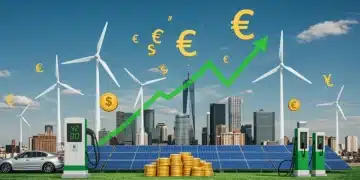2025 Energy Regulations: 10% Cost Cut for US Industry?

The 2025 energy regulations are poised to offer U.S. industrial sectors a significant 10% cost reduction opportunity by driving enhanced energy efficiency and promoting sustainable operational shifts across various industries.
The impending 2025 energy regulations are creating a buzz across U.S. industrial sectors, not just as a compliance challenge but as a potential pathway to significant operational savings. Could these new rules truly unlock a 10% cost reduction opportunity for businesses?
Understanding the 2025 Energy Regulations Framework
The U.S. government is rolling out new energy regulations for 2025, designed to accelerate the transition to a cleaner, more efficient energy landscape. These regulations target various aspects of industrial operations, from energy consumption benchmarks to emissions standards, aiming to reduce the national carbon footprint and bolster energy independence.
These new rules are not merely punitive; they are structured to incentivize innovation and investment in energy-saving technologies. Early adopters and those who strategically plan their compliance can turn these mandates into competitive advantages, potentially realizing substantial long-term savings through reduced energy expenditures and improved operational efficiencies.
Key Regulatory Pillars
- Emissions Reduction Targets: Mandates for specific greenhouse gas reductions, driving investment in cleaner production methods.
- Energy Efficiency Standards: New benchmarks for industrial equipment and facility energy performance, pushing for upgrades.
- Renewable Energy Integration: Incentives and requirements for incorporating renewable energy sources into industrial power mixes.
- Reporting and Transparency: Stricter guidelines for energy consumption and emissions reporting, fostering accountability.
Identifying the 10% Cost Reduction Opportunity
Many industry analysts and government reports suggest a realistic 10% cost reduction opportunity for U.S. industrial sectors under the new 2025 energy regulations. This isn’t a guaranteed outcome but a potential benefit for companies that proactively adapt and invest. The savings stem from several areas, primarily focused on minimizing waste and optimizing energy use.
By upgrading to more efficient machinery, implementing smart energy management systems, and leveraging renewable energy sources, businesses can drastically cut their utility bills. The initial investment in these changes is often offset by tax credits, grants, and the long-term operational savings, making a 10% reduction a tangible goal for many.
Strategic Areas for Savings
- Equipment Modernization: Replacing old, inefficient machinery with state-of-the-art, energy-efficient models.
- Process Optimization: Re-engineering industrial processes to consume less energy.
- Waste Heat Recovery: Capturing and reusing heat generated during industrial operations.
- Demand-Side Management: Adjusting energy consumption patterns to take advantage of off-peak pricing and reduce peak demand charges.
Impact on Specific U.S. Industrial Sectors
The impact of the 2025 energy regulations will vary across different U.S. industrial sectors, with some facing greater challenges and others finding more immediate opportunities for cost reduction. Energy-intensive industries, such as manufacturing, chemicals, and metals, are expected to feel the most direct effects, but also stand to gain the most from efficiency improvements.
For example, the steel industry, traditionally a high energy consumer, can achieve significant savings through electric arc furnace technologies and improved insulation. Conversely, sectors like light manufacturing or food processing might focus more on optimizing HVAC systems and implementing smart lighting controls. Each sector will need a tailored approach to maximize the benefits of the new regulations.

Sector-Specific Challenges and Opportunities
In the manufacturing sector, the drive for efficiency will likely focus on optimizing production lines and adopting advanced robotics that consume less power. The chemical industry, with its complex processes, could see benefits from advanced process control systems and improved catalyst technologies that reduce energy input. For the food and beverage industry, refrigeration and heating are major energy sinks, making upgrades in these areas critical for cost reduction. Each industry’s unique energy profile dictates its path to compliance and savings under the 2025 energy regulations.
Leveraging Technology for Compliance and Savings
Technology plays a pivotal role in navigating the 2025 energy regulations and achieving the projected 10% cost reduction. Advanced energy management systems (EMS) are becoming indispensable tools, offering real-time monitoring, data analytics, and predictive capabilities to optimize energy use across industrial facilities. These systems can identify inefficiencies, suggest improvements, and even automate adjustments to machinery and processes.
Beyond EMS, the adoption of Internet of Things (IoT) devices, artificial intelligence (AI), and machine learning (ML) is transforming how industries consume and manage energy. IoT sensors can provide granular data on equipment performance, while AI algorithms can analyze vast datasets to predict energy demand and optimize supply. These technologies not only ensure compliance but also drive continuous improvement in energy efficiency, making the 10% saving more achievable.
Technological Solutions for Energy Efficiency
- Smart Sensors and IoT: Real-time data collection on energy consumption and equipment performance.
- AI-Powered Analytics: Predictive maintenance, demand forecasting, and optimization algorithms.
- Advanced Control Systems: Automated adjustments to processes and equipment for peak efficiency.
- Energy Storage Solutions: Battery storage and other technologies to manage peak demand and integrate renewables.
Financial Incentives and Support Programs
To ease the transition and encourage compliance with the 2025 energy regulations, various financial incentives and support programs are available at federal, state, and local levels. These programs can significantly reduce the upfront costs associated with energy efficiency upgrades and renewable energy installations, making the 10% cost reduction opportunity even more attractive.
Federal tax credits, such as the Investment Tax Credit (ITC) for solar and other renewable energy projects, are crucial. State and local governments often offer grants, rebates, and low-interest loans for specific energy-saving initiatives. Additionally, utility companies frequently provide incentives for demand-side management programs and energy efficiency improvements. Businesses should actively research and apply for these programs to maximize their financial benefits.
Types of Financial Assistance
- Federal Tax Credits: Direct reductions in tax liability for qualifying energy investments.
- State and Local Grants: Funding for specific energy efficiency or renewable energy projects.
- Utility Rebates: Incentives from energy providers for upgrading to more efficient equipment.
- Loan Programs: Low-interest financing options for energy-related capital expenditures.
Navigating Compliance and Future Outlook
Navigating the complex landscape of the 2025 energy regulations requires a proactive and strategic approach. Companies must conduct thorough energy audits to identify areas for improvement, develop comprehensive implementation plans, and stay informed about evolving regulatory details. Engaging with energy consultants and industry associations can provide invaluable guidance and support.
The long-term outlook suggests that energy efficiency and sustainability will only grow in importance, driven by both regulatory pressures and market demands. Businesses that embrace these changes now will be better positioned for future growth, enhanced competitiveness, and resilience against fluctuating energy prices. The 10% cost reduction is not just a short-term gain but a foundation for sustainable operational excellence, shaping the future of U.S. industrial sectors.
As the deadline approaches, firms are advised to assess their current energy consumption, identify potential areas of non-compliance, and begin formulating strategies for a smooth transition. This forward-looking stance will not only help meet the regulatory requirements but also unlock the significant economic benefits these changes offer. The evolving regulatory environment emphasizes a shift towards a more sustainable and economically savvy industrial future.
| Key Point | Brief Description |
|---|---|
| Regulatory Framework | New U.S. energy regulations for 2025 mandate efficiency and emissions reductions. |
| 10% Cost Reduction | Proactive adaptation to regulations can lead to a 10% decrease in operational energy costs. |
| Technological Leverage | Adopting EMS, IoT, and AI is crucial for compliance and maximizing efficiency gains. |
| Financial Incentives | Federal, state, and utility programs offer support for energy efficiency investments. |
Frequently Asked Questions About 2025 Energy Regulations
The primary goals are to reduce U.S. industrial carbon emissions, improve energy efficiency across sectors, and promote the adoption of sustainable energy practices. These regulations aim to foster a greener economy and enhance national energy security by minimizing reliance on fossil fuels.
A 10% cost reduction is achievable through strategic investments in energy-efficient equipment, process optimization, waste heat recovery, and integrating renewable energy sources. Leveraging smart energy management systems and financial incentives also plays a crucial role in realizing these savings.
Energy-intensive sectors such as manufacturing, chemicals, steel, and cement production are expected to be most significantly affected. These industries have the largest potential for both compliance challenges and substantial cost savings through efficiency improvements.
Key technological solutions include advanced energy management systems (EMS), Internet of Things (IoT) devices for real-time monitoring, artificial intelligence (AI) for predictive analytics, and process automation. These tools help optimize energy consumption and ensure regulatory adherence.
Yes, numerous financial incentives exist, including federal tax credits (e.g., ITC), state and local grants, rebates from utility companies, and low-interest loan programs. These programs are designed to support businesses in making necessary energy-related investments.
What Happens Next
As the 2025 energy regulations draw nearer, U.S. industrial sectors are entering a critical phase of assessment and strategic planning. The coming months will see a surge in energy audits, technology procurements, and training initiatives as companies strive to meet new benchmarks and capitalize on potential cost reductions. Expect increased collaboration between industry leaders, technology providers, and government agencies to streamline compliance and innovation. The focus will remain on developing scalable, sustainable solutions that not only adhere to regulations but also enhance global competitiveness, forging a more energy-resilient industrial future.





